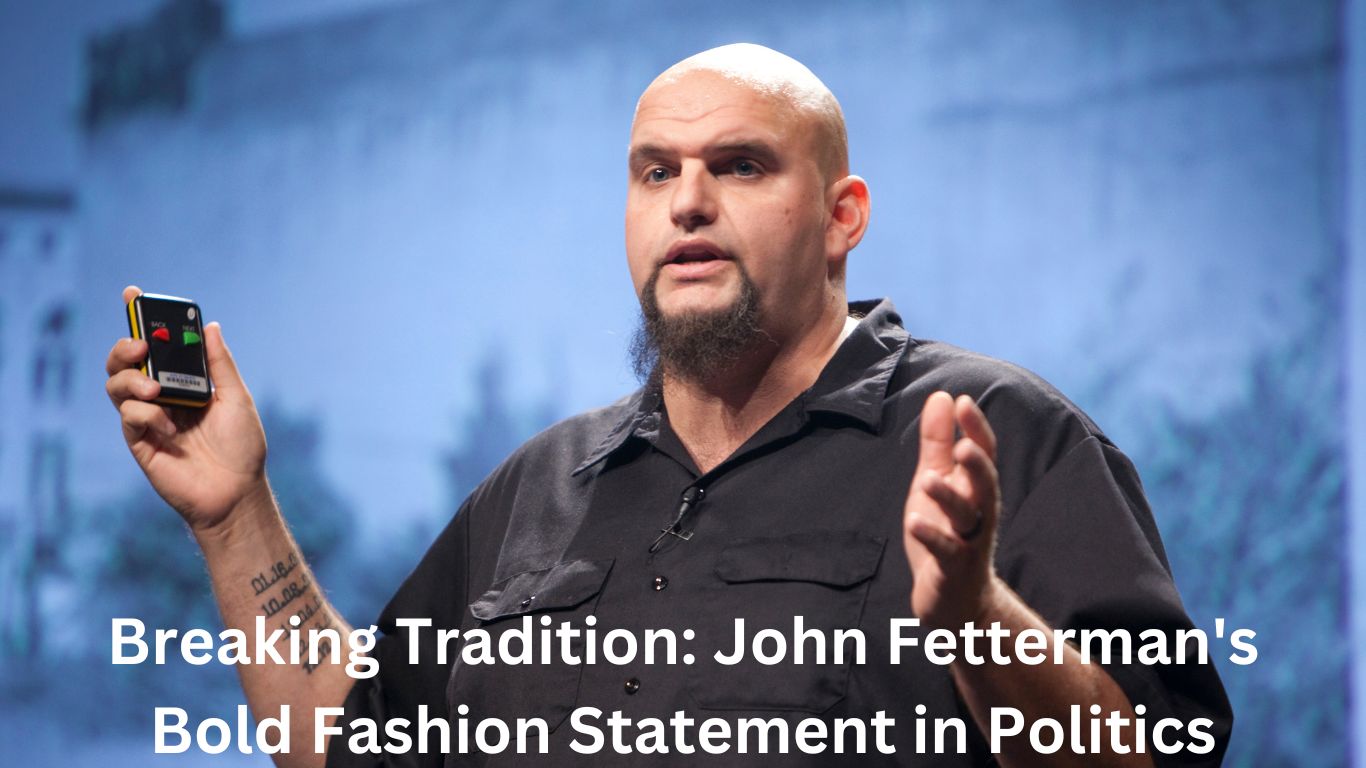Outline:
- Introduction
1.1. Brief overview of the event
1.2. Introduction of Sen. John Fetterman
1.3. Setting the stage for the unusual outfit choice - Sen. Fetterman’s Fashion Statement
2.1. Description of his outfit: Shorts and Sneakers
2.2. Breaking traditional norms in political attire
2.3. The impact of his attire on public perception - Why Was His Outfit So Controversial?
3.1. Traditional expectations of political attire
3.2. The symbolism of the front row at a major event
3.3. Social media reactions - Sen. Fetterman’s Personal Style
4.1. His history of defying political fashion norms
4.2. How he uses clothing to represent his values
4.3. The rise of “casual” in politics - The Politics of Clothing
5.1. Fashion and its influence on political identity
5.2. Other politicians who have challenged clothing conventions
5.3. The changing attitudes towards formality in politics - The Significance of the Front Row
6.1. What sitting in the front row represents
6.2. Fetterman’s position in the political hierarchy
6.3. The symbolism of being visible at such an event - Public and Media Reactions
7.1. Positive responses to Fetterman’s unconventional look
7.2. Criticism and backlash from traditionalists
7.3. The role of media in shaping the narrative - A New Era for Political Fashion?
8.1. How Fetterman’s appearance may influence future politicians
8.2. The evolving expectations of political figures
8.3. The democratization of style in politics - Conclusion
9.1. Summary of Fetterman’s impact on political fashion
9.2. Final thoughts on breaking traditions in political representation
9.3. Looking ahead: Will this become the new norm? - FAQs
10.1. Why did Sen. Fetterman wear shorts to a formal event?
10.2. How does Sen. Fetterman’s fashion represent his political views?
10.3. What was the public reaction to Fetterman’s outfit?
10.4. Is this a sign of changing political norms?
10.5. How have other politicians challenged traditional dress codes?
Introduction
On the day of Donald Trump’s inauguration, an event that traditionally calls for formal attire, a surprising figure caught the eyes of attendees and millions of viewers worldwide. Sen. John Fetterman made headlines not for his political speech or actions, but for his choice of outfit—shorts and sneakers. This bold move sparked widespread discussion, and we’re diving into the significance of this fashion statement. From breaking norms to influencing public perceptions, Fetterman’s outfit set a new precedent that had everyone talking.
Sen. Fetterman’s Fashion Statement
Description of His Outfit: Shorts and Sneakers
Sen. John Fetterman’s choice of attire was nothing short of unexpected for such a high-profile occasion. While most attendees sported suits and ties or dresses, Fetterman opted for a pair of dark shorts and sneakers. This unconventional ensemble, which included a casual shirt, clashed with the typical formal wear associated with such important political events.
Breaking Traditional Norms in Political Attire
This was not the first time Fetterman has pushed the envelope when it comes to his clothing choices. Known for his casual style, he has consistently chosen to wear clothing that resonates with his down-to-earth, approachable persona. By wearing shorts and sneakers to Trump’s inauguration, Fetterman boldly challenged the unspoken dress codes that have long been a part of political events.
The Impact of His Attire on Public Perception
Fetterman’s attire wasn’t just a statement about fashion; it was a message. By appearing in front of the nation in such an informal outfit, he conveyed the idea that politics does not have to be about adhering to traditional, sometimes elitist, standards. His outfit sent a clear signal that you don’t need to wear a suit to be taken seriously, opening the door for more relaxed representations of political figures.
Why Was His Outfit So Controversial?
Traditional Expectations of Political Attire
Politics has long been associated with a strict dress code. Whether it’s the sharp suits of presidents or the formal attire of senators, traditional politics has demanded that its figures present themselves in a certain way. Fetterman’s choice to wear casual clothing at such an important event ran counter to these expectations, raising eyebrows across both social and political media platforms.
The Symbolism of the Front Row at a Major Event
Sitting in the front row at an inauguration is not just about being physically close to the action—it’s a symbolic gesture of influence, power, and authority. For someone like Fetterman, who was still relatively new to the Senate at the time, the decision to dress casually in such a prominent spot was a statement about his priorities and personality. It wasn’t just about challenging dress codes; it was about making a statement in one of the most visible spaces.
Social Media Reactions
Unsurprisingly, Fetterman’s outfit became a hot topic on social media. While some praised him for breaking the mold and showing authenticity, others criticized him for disrespecting the occasion. This divide reflects the broader tension between modernizing politics and holding on to long-standing traditions.
Sen. Fetterman’s Personal Style
History of Defying Political Fashion Norms
Fetterman’s choice to wear casual attire is hardly a one-off moment. Throughout his political career, he has been known for his relaxed style. Whether it’s oversized hoodies or casual wear, Fetterman has consistently opted for comfort over formality. This departure from the traditional, often stiff political fashion may be a reflection of his working-class background, where casual attire is more the norm than the exception.
How He Uses Clothing to Represent His Values
For Fetterman, his wardrobe isn’t just about personal comfort—it’s a reflection of his values. By wearing casual clothing, he is symbolizing accessibility, authenticity, and the idea that politics should not be a space reserved only for the elite. His choices align with his efforts to represent working-class constituents who may feel disconnected from the traditional political establishment.
The Rise of “Casual” in Politics
Fetterman’s fashion choices are part of a broader trend of more casual attire in politics. As younger generations of politicians begin to rise through the ranks, the old conventions of political dress are being challenged. Clothing is now being seen less as a symbol of authority and more as a personal statement.
The Politics of Clothing
Fashion and Its Influence on Political Identity
The relationship between fashion and political identity is complex. Historically, political figures used clothing to signal their status, values, and authority. However, as society evolves, so too do the expectations for how politicians should present themselves. Fetterman’s choice to wear shorts and sneakers represents a shift in how political figures can express their individuality while still fulfilling their roles.
Other Politicians Who Have Challenged Clothing Conventions
Fetterman is not alone in challenging the dress codes of political events. Several politicians, including Bernie Sanders and Alexandria Ocasio-Cortez, have also broken away from traditional attire. These instances highlight the growing movement towards more inclusive, authentic representations of political figures.
The Changing Attitudes Towards Formality in Politics
The rise of casual attire among politicians can be seen as part of a larger societal trend towards informality. As we move further into the 21st century, the line between formal and casual attire is becoming increasingly blurred, even in spaces where professionalism was once the defining characteristic.
The Significance of the Front Row
What Sitting in the Front Row Represents
The front row at an event like an inauguration is not just a prime viewing spot; it’s a seat reserved for the most influential and important figures. By choosing to sit in this prestigious location, Fetterman was asserting his role on the national stage and signaling that his unconventional style wasn’t a barrier to his influence.
Fetterman’s Position in the Political Hierarchy
While relatively new to the Senate, Fetterman’s appearance in the front row suggested that he was already carving out a significant role in the political landscape. His unconventional appearance only seemed to strengthen his image as a figure who was willing to break from tradition.
The Symbolism of Being Visible at Such an Event
In addition to the fashion statement, Fetterman’s presence in the front row at a major political event symbolized his determination to be seen and heard. His decision to make such a bold statement in a highly visible position reinforced the idea that political representation is about more than appearances.
Public and Media Reactions
Positive Responses to Fetterman’s Unconventional Look
While Fetterman’s outfit was controversial, many people applauded him for his bravery. Supporters viewed his attire as a breath of fresh air in a space that is often seen as outdated and elitist. For them, it represented a break from the norms that have long been associated with political leadership.
Criticism and Backlash from Traditionalists
On the flip side, some critics viewed Fetterman’s casual attire as disrespectful and inappropriate. To them, an inauguration was a solemn occasion that required formal attire. They argued that Fetterman’s choice to wear shorts was a reflection of his lack of seriousness.
The Role of Media in Shaping the Narrative
Media outlets played a pivotal role in shaping public opinion on Fetterman’s fashion choice. While some outlets focused on his defiance of tradition, others analyzed the political implications of his outfit. This wide range of media coverage highlights the ongoing debate over the intersection of fashion and politics.
A New Era for Political Fashion?
How Fetterman’s Appearance May Influence Future Politicians
As more politicians begin to follow in Fetterman’s footsteps, we may see a shift in the way political figures present themselves. His fashion choice could inspire future leaders to embrace a more casual, relatable approach to dressing, breaking down the walls of elitism that often surround the political sphere.
The Evolving Expectations of Political Figures
Expectations around political attire are shifting. While traditionalists may resist these changes, younger generations are embracing a new vision of political engagement—one that values authenticity and accessibility over formality.
The Democratization of Style in Politics
Fetterman’s outfit symbolizes the democratization of style in politics. As barriers around traditional political attire are dismantled, a new form of representation is emerging, one that connects more deeply with everyday people.
Conclusion
In a world where tradition and modernity often clash, Sen. John Fetterman’s choice to wear shorts and sneakers to a major political event stands as a powerful symbol of change. His bold fashion statement may have broken expectations, but it also opened up a conversation about the evolving role of personal style in politics. Whether you love it or hate it, Fetterman’s outfit made a statement: that politics should be more inclusive, more approachable, and more human.
FAQs
Why did Sen. Fetterman wear shorts to a formal event?
Fetterman wore shorts to challenge traditional political fashion norms and promote a message of authenticity and accessibility.
How does Sen. Fetterman’s fashion represent his political views?
His fashion choices reflect his down-to-earth, working-class values and his commitment to making politics more relatable.
What was the public reaction to Fetterman’s outfit?
While some praised his boldness, others criticized it as disrespectful to the occasion.
Is this a sign of changing political norms?
Yes, Fetterman’s outfit may signal a shift towards a more casual and inclusive political culture.
How have other politicians challenged traditional dress codes?
Politicians like Bernie Sanders and Alexandria Ocasio-Cortez have also made waves with their non-traditional clothing choices, further contributing to this trend.










